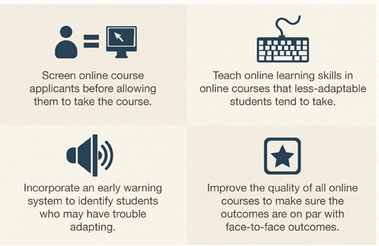What is at the core of an online course or a MOOC? You could argue it’s the academic integrity of the materials or learning. It could be the level of student engagement in required activities. I would argue that (even if not at the core, but very close to it) should be the expectations placed on the students both academically and technically!
There’s no point having a good (large, massive?) number of students enrolled on the course if you already know that a proportion of them are not technically or academically capable of engaging or completing the course. Is this one of the criticisms of MOOCs?

The Characteristics Of A Successful Online Student
What does this infographic say? Well:
- Screen applicants before allowing them start study: Not always possible I would think. By nature of the course being online you would hope they are aware of technical limitations in their own ability and consider this before applying. What about asking students to complete an online activity as part of the application process (within the learning environment maybe?) to assess their abilities (assignment submission, online discussion, etc)? It could be done, but what about the overheads placed on the course team members to administer these types of activities?
- Teach online learning skills: Yes, this is / should be part of the orientation week / induction week (Hopkins et al, 2010) / introductory activities where the students can engage with the technology on non-subject specific activities to help align themselves with their peers and the course team. From here they are then able to use the skills in the learning without needing to learn the technology at the same time.
- Early-warning systems: Not sure how you would do this at scale, but certainly knowing the attendees on the course and monitoring how they engage and interact will help form a basis for knowing if or when a problem arises, as well as making contact with those who are less vocal than the rest, to see if they are struggling or need further information or help – remember, the quiet ones are not always in trouble, they could just be listening!
- Improve quality: Always yes, yes, yes! Each cohort of students should have the ability to feedback to the course leaders on their experiences (positive and negative) and this feedback should help the course team rework or adjust the materials to fill any blanks or difficult areas. It’s not only the marks that count, as these can mask areas where there are gaps or problems.
This is one reason I liked the ALT #ocTEL MOOC so much: we had a settling-in / induction week where we were able to wonder around the online environment, find our feet, find our friends, learn the subtleties of the platform, and make arrangements for our own interactions and how we’d engage (as well as where).
Resources:
Hopkins, D., Wincott, M. and Hutchings, L., 2011. Building educational confidence and affinity through Online Induction Activities. In: Bournemouth University Education Enhancement Conference 2011, 4 May 2011, Bournemouth University, Poole, England. Available from: http://www.dontwasteyourtime.co.uk/elearning/poster-building-educational-confidence-and-affinity-through-online-induction-activities/


